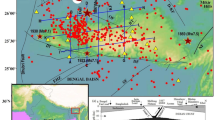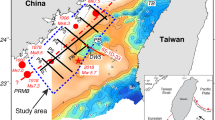Abstract
Segments of subduction zones that are capable of generating tsunamigenic earthquakes appear to have characteristic structural configurations. These structures include heterogeneous plate interfaces, a small wedge of deformed sediment at the toe of the overriding plate (the frontal prism), and splay faults in the crust of the overriding plate that root within the plate boundary megathrust. Here we use seismic reflection imaging to show that these features also exist within a creeping segment of the Alaska subduction zone, the Shumagin Gap. We identify an active crustal-scale normal fault system that dips landward and resembles that involved in the 2011 Tohoku-oki earthquake in Japan. We also find that the Shumagin Gap has a small frontal prism, a deep-water splay fault, and that the plate interface here is rough and thinly sedimented. We propose that lateral propagation of rupture from a neighbouring segment into the Shumagin Gap may explain a tsunamigenic earthquake that occurred there in 1788 and that tsunamigenic potential should be considered in hazard assessments for the region. Our results demonstrate that structural configurations similar to those in Tohoku may exist in other subduction zones, including within creeping segments or segments with no record of historical megathrust earthquakes, but are under-recognized. Identifying similar configurations globally may improve our ability to anticipate regions capable of generating large tsunamis.
This is a preview of subscription content, access via your institution
Access options
Access Nature and 54 other Nature Portfolio journals
Get Nature+, our best-value online-access subscription
$29.99 / 30 days
cancel any time
Subscribe to this journal
Receive 12 print issues and online access
$259.00 per year
only $21.58 per issue
Buy this article
- Purchase on Springer Link
- Instant access to full article PDF
Prices may be subject to local taxes which are calculated during checkout



Similar content being viewed by others
References
Kanamori, H. Mechanism of tsunami earthquakes. Phys. Earth Planet. Inter. 6, 346–359 (1972).
Polet, J. & Kanamori, H. Shallow subduction zone earthquakes and their tsunamigenic potential. Geophys. J. Int. 142, 684–702 (2000).
Tsuji, T. et al. Extension of continental crust by anelastic deformation during the 2011 Tohoku-oki earthquake: the role of extensional faulting in the generation of a great tsunami. Earth Planet. Sci. Lett. 364, 44–58 (2013).
Okamura, Y. et al. Fore arc structure and plate boundary earthquake sources along the southwestern Kuril subduction zone. J. Geophys. Res. 113, B06305 (2008).
Li, S. Y., Moreno, M., Rosenau, M., Melnick, D. & Oncken, O. Splay fault triggering by great subduction earthquakes inferred from finite element models. Geophys. Res. Lett. 41, 385–391 (2014).
Xu, S. Q., Fukuyama, E., Yue, H. & Ampuero, J. P. Simple crack models explain deformation induced by subduction zone megathrust earthquakes. Bull. Seismol. Soc. Am. 106, 2275–2289 (2016).
McKenzie, D. & Jackson, J. Tsunami earthquake generation by the release of gravitational potential energy. Earth Planet. Sci. Lett. 345, 1–8 (2012).
Ide, S., Baltay, A. & Beroza, G. C. Shallow dynamic overshoot and energetic deep rupture in the 2011 M-w 9.0 Tohoku-Oki earthquake. Science 332, 1426–1429 (2011).
Tsuji, T. et al. Potential tsunamigenic faults of the 2011 off the Pacific coast of Tohoku Earthquake. Earth Planets Space 63, 831–834 (2011).
Klaeschen, D., Belykh, I., Gnibidenko, H., Patrikeyev, S. & Vonhuene, R. Structure of the Kuril trench from seismic-reflection records. J. Geophys. Res. 99, 24173–24188 (1994).
Bilek, S. L. & Engdahl, E. R. Rupture characterization and aftershock relocations for the 1994 and 2006 tsunami earthquakes in the Java subduction zone. Geophys. Res. Lett. 34, L20311 (2007).
Satake, K. Mechanism of the 1992 Nicaragua tsunami earthquake. Geophys. Res. Lett. 21, 2519–2522 (1994).
Correa-Mora, F. et al. GPS-derived coupling estimates for the Central America subduction zone and volcanic arc faults: El Salvador, Honduras and Nicaragua. Geophys. J. Int. 179, 1279–1291 (2009).
Nicolsky, D., Freymueller, J., Witter, R., Suleimani, E. & Koehler, R. Evidence for shallow megathrust slip across the Unalaska seismic gap during the great 1957 Andreanof Islands earthquake, eastern Aleutian Islands, Alaska. Geophys. Res. Lett. 43, 10328–10337 (2016).
Lopez, A. M. & Okal, E. A. A seismological reassessment of the source of the 1946 Aleutian ‘tsunami’ earthquake. Geophys. J. Int. 165, 835–849 (2006).
Davies, J., Sykes, L., House, L. & Jacob, K. Shumagin seismic gap, Alaska Peninsula—history of great earthquakes, tectonic setting, and evidence for high seismic potential. J. Geophys. Res. 86, 3821–3855 (1981).
Fournier, T. J. & Freymueller, J. T. Transition from locked to creeping subduction in the Shumagin region, Alaska. Geophys. Res. Lett. 34, L06303 (2007).
Kirby, S., Scholl, D., von Huene, R. & Wells, R. Alaska Earthquake Source for the SAFRR Tsunami Scenario: Chapter B in The SAFRR (Science Application for Risk Reduction) Tsunami Scenario 33–79 (Report No. 2331–1258, US Geological Survey, 2013).
Wang, K. L. & Bilek, S. L. Invited review paper: fault creep caused by subduction of rough seafloor relief. Tectonophysics 610, 1–24 (2014).
Bruns, T. R., von Huene, R., Culotta, R. C., Lewis, S. D. & Ladd, J. W. in Geology and Resource Potential of the Continental Margin of Western North America and Adjacent Ocean Basins, Beaufort Sea to Baja California Vol. 6 (eds Scholl, D. W., Grantz, A. & Vedder, J.) Ch. 8, 157–190 (Circum-Pacific Council for Energy and Mineral Resources, 1987).
Li, J. Y. et al. Downdip variations in seismic reflection character: implications for fault structure and seismogenic behavior in the Alaska subduction zone. J. Geophys. Res. 120, 7883–7904 (2015).
Estabrook, C. H., Jacob, K. H. & Sykes, L. R. Body wave and surface-wave analysis of large and great earthquakes along the eastern Aleutian Arc, 1923–1993—implications for future events. J. Geophys. Res. 99, 11643–11662 (1994).
Abers, G. A. Relationship between shallow-depth and intermediate-depth seismicity in the eastern Aleutian subduction zone. Geophys. Res. Lett. 19, 2019–2022 (1992).
Shillington, D. J. et al. Link between plate fabric, hydration and subduction zone seismicity in Alaska. Nat. Geosci. 8, 961–964 (2015).
Bilek, S. L. The role of subduction erosion on seismicity. Geology 38, 479–480 (2010).
Moore, G. F. et al. Three-dimensional splay fault geometry and implications for tsunami generation. Science 318, 1128–1131 (2007).
Tanioka, Y., Ruff, L. & Satake, K. What controls the lateral variation of large earthquake occurrence along the Japan Trench? Island Arc 6, 261–266 (1997).
Saffer, D. M. & Wallace, L. M. The frictional, hydrologic, metamorphic and thermal habitat of shallow slow earthquakes. Nat. Geosci. 8, 594–600 (2015).
Contreras-Reyes, E., Flueh, E. R. & Grevemeyer, I. Tectonic control on sediment accretion and subduction off south central Chile: implications for coseismic rupture processes of the 1960 and 2010 megathrust earthquakes. Tectonics 29, TC6018 (2010).
Ito, Y. et al. Frontal wedge deformation near the source region of the 2011 Tohoku-Oki earthquake. Geophys. Res. Lett. 38, L00G05 (2011).
Cubas, N., Avouac, J. P., Leroy, Y. M. & Pons, A. Low friction along the high slip patch of the 2011 Mw 9.0 Tohoku-Oki earthquake required from the wedge structure and extensional splay faults. Geophys. Res. Lett. 40, 4231–4237 (2013).
Wendt, J., Oglesby, D. D. & Geist, E. L. Tsunamis and splay fault dynamics. Geophys. Res. Lett. 36, L15303 (2009).
Syracuse, E. M., van Keken, P. E. & Abers, G. A. The global range of subduction zone thermal models. Phys. Earth Planet. Inter. 183, 73–90 (2010).
Hyndman, R. D. & Wang, K. Thermal constraints on the zone of major thrust earthquake failure—the cascadia subduction zone. J. Geophys. Res. 98, 2039–2060 (1993).
Ammon, C. J. et al. Rupture process of the 2004 Sumatra-Andaman earthquake. Science 308, 1133–1139 (2005).
Noda, H. & Lapusta, N. Stable creeping fault segments can become destructive as a result of dynamic weakening. Nature 493, 518–521 (2013).
Freymueller, J. T. et al. Active Tectonics and Seismic Potential of Alaska 1–42 (American Geophysical Union, 2008).
Bird, P. An updated digital model of plate boundaries. Geochem. Geophys. Geosyst. 4, 1027 (2003).
Sella, G. F., Dixon, T. H. & Mao, A. L. REVEL: a model for recent plate velocities from space geodesy. J. Geophys. Res. 107, ETG 11-1–ETG-11–30 (2002).
Abers, G. A., Hu, X. X. & Sykes, L. R. Source scaling of earthquakes in the Shumagin region, Alaska—time-domain inversions of regional wave-forms. Geophys. J. Int. 123, 41–58 (1995).
Choo, J., Downton, J. & Dewar, J. Lift: A new and practical approach to noise and multiple attenuation. First Break 22, 39–44 (2004).
Caress, D. W. & Chayes, D. N. New software for processing sidescan data from sidescan-capable multibeam sonars. In Proc. IEEE Oceans 95 Conf. 997–1000 (MTS/IEEE, 1995).
Hobro, J. W. D., Singh, S. C. & Minshull, T. A. Three-dimensional tomographic inversion of combined reflection and refraction seismic traveltime data. Geophys. J. Int. 152, 79–93 (2003).
Zelt, C. A. & Smith, R. B. Seismic traveltime inversion for 2-D crustal velocity structure. Geophys. J. Int. 108, 16–34 (1992).
Janiszewski, H. A., Abers, G. A., Shillington, D. J. & Calkins, J. A. Crustal structure along the Aleutian island arc: new insights from receiver functions constrained by active-source data. Geochem. Geophys. Geosyst. 14, 2977–2992 (2013).
Abers, G. A. 3-dimensional inversion of regional p and s arrival times in the East Aleutians and sources of Subduction Zone Gravity Highs. J. Geophys. Res. 99, 4395–4412 (1994).
Wiemer, S. & Wyss, M. Minimum magnitude of completeness in earthquake catalogs: examples from Alaska, the western United States, and Japan. Bull. Seismol. Soc. Am. 90, 859–869 (2000).
Acknowledgements
We gratefully acknowledge the captain, technical staff and crew of the RV Marcus G. Langseth and the Scripps OBS team who made this data set possible. This work was supported by the US National Science Foundation grants OCE-0926614 and EAR-1347312.
Author information
Authors and Affiliations
Contributions
D.J.S., M.R.N. and S.C.W. obtained funding for the marine seismic programme. D.J.S., A.B., M.R.N., S.C.W. and M.D. collected marine data during the research cruise on RV Langseth. A.B., G.A.A., K.M.K., D.J.S., M.R.N. and D.M.S. obtained funding for seismicity and seismic data integration. A.B. conducted the MCS processing. D.J.S. performed the wide-angle reflection/refraction modelling. K.M.K. and G.A.A. analysed the seismicity data. All authors discussed the results and commented on the manuscript.
Corresponding author
Ethics declarations
Competing interests
The authors declare no competing financial interests.
Supplementary information
Supplementary Information
Supplementary Information (PDF 135021 kb)
Rights and permissions
About this article
Cite this article
Bécel, A., Shillington, D., Delescluse, M. et al. Tsunamigenic structures in a creeping section of the Alaska subduction zone. Nature Geosci 10, 609–613 (2017). https://doi.org/10.1038/ngeo2990
Received:
Accepted:
Published:
Issue Date:
DOI: https://doi.org/10.1038/ngeo2990
This article is cited by
-
Forearc seismogenesis in a weakly coupled subduction zone influenced by slab mantle fluids
Nature Geoscience (2023)
-
Fast and slow intraplate ruptures during the 19 October 2020 magnitude 7.6 Shumagin earthquake
Nature Communications (2023)
-
Aseismic slip and recent ruptures of persistent asperities along the Alaska-Aleutian subduction zone
Nature Communications (2022)
-
Localized extension in megathrust hanging wall following great earthquakes in western Nepal
Scientific Reports (2021)



